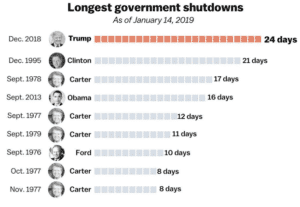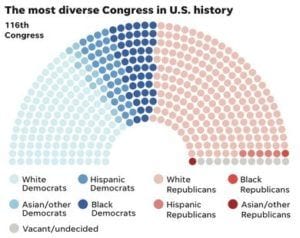In 1978, Kenny Rogers released “The Gambler,” a song that details the sage advice of an avid poker player. The lyrics famously contain the chorus, “You’ve got to know when to hold ‘em, know when to fold ‘em, know when to walk away, know when to run.” Fittingly, the song debuted less than a month after a government shutdown. Now, over 40 years later, President Trump may be wishing he’d added the song to his playlist five weeks ago.
The government shutdown has officially ended after reaching the 35-day mark, becoming the longest in American history. The Trump administration refused to fund the government without at least $5.7 billion being set aside for construction of a wall on the southern border.1 After saying he would “take the mantle” for the shutdown, the president gave a televised address attempting to outline why he felt the wall was essential for border security and why shutting down the government to ensure its funding was necessary.2
During the course of those five weeks, over 800,000 federal workers missed two paychecks, accounting for over $6 billion in delayed wages.3 These workers will eventually be reimbursed, but the numerous businesses who depend on those workers to spend their earnings will not be. Furthermore, an S&P Global Ratings estimate places the total impact on the U.S. economy over the course of the shutdown as at least $6 billion, a full $300 million more than the desired wall funding.4
Worst of all for the Trump administration is that after 35 days of holding out, the shutdown ended without a single dollar allocated for the wall. The funding package passed by Congress and signed by the president is virtually identical to the package President Trump refused to approve, triggering the shutdown.5
However, it may not really be over.
As it stands, the government is funded only until February 15. Congress must pass a new funding package by then to keep the government running throughout the remainder of fiscal year 2019 (which ends on September 30). President Trump has suggested that the three-week period will give his administration and congressional Republicans time to reach a new deal with Democrats, which may include funding for the wall. Democrats have already signaled that will not be the case.6
President Trump is now left with two options. As he has already suggested, he may initiate another shutdown on February 15 if the requested $5.7 billion for wall funding is not in the new budget. Alternatively, he could declare a state of emergency on the southern border and use his powers as commander-in-chief to order the military to begin construction on the wall to the tune of $7 billion.7
President Trump and members of his administration have already promoted this second option, as a way of ending the first shutdown. Promoters suggest that not only is this the president’s right, but that it offers a way of keeping his campaign promises without bringing the government to a stand-still.8 Detractors argue that a wall is an effective solution for border security, and a majority of Americans do not want it.9
For more on public opinion and understanding of the issue, see How Americans see Illegal Immigration, the Border Wall and Political Compromise from the Pew Research Center
Furthermore, the president’s right to use the military for the wall’s construction is not certain and many have objected to the use of $7 billion in disaster relief funds, which may negatively impact ongoing relief efforts in Puerto Rico, California, and Texas.10
As the next three weeks play out, I know that I’ll be listening to “The Gambler” a least a few times.
Discussion Questions
1) Ask students to conduct a take-a-stand. On side A, “The importance of the wall made a government shutdown necessary,” and on side B, “The wall was not important enough to shut down the government.” Once students have taken their positions, hold a discussion or a brief debate so they can share their perspectives.
2) One of the core principles of the Constitution is the idea of compromise. If the president decides a policy is important, should Congress be expected to incorporate elements of it into their decision-making? Is it reasonable for Congress to reject a presidential policy outright?
3) If no funding for a border wall is allocated by February 15, should the president allow the government to shut down again? Should he declare a state of emergency to build the wall and avoid shutting down the government? Are there other options to consider?
4) Should the president be allowed to declare a state of emergency to accomplish a policy goal that Congress has already rejected? Does the president’s role as commander-in-chief and primary executor of the law give him the right to use the military to enact a security policy? Does the use of the military and the reallocation of disaster relief funding constitute an overreach of executive authority?
Sources
Featured Image: Photo by Pedro Pardo, AFP; source: The Mercury News
[1] Vox: https://www.vox.com/policy-and-politics/2019/1/8/18171913/shutdown-trump-speech-wall-funding
[2] Washington Post: https://www.washingtonpost.com/opinions/trump-owns-this-shutdown-debacle/2019/01/15/ca41aac8-18dc-11e9-88fe-f9f77a3bcb6c_story.html?utm_term=.f3684b9f50fa
[3] Federal News Network: https://federalnewsnetwork.com/government-shutdown/2019/01/by-the-numbers-how-much-money-is-the-shutdown-costing-fed-families/
[4] Fox Business: https://www.foxbusiness.com/economy/heres-how-much-the-government-shutdown-cost-according-to-sp
[5] The Atlantic: https://www.theatlantic.com/politics/archive/2019/01/shutdown-over-trump-relents/581323/
[7] New York Times: https://www.nytimes.com/2019/01/25/us/politics/trump-shutdown-deal.html
[8] CNN: https://www.cnn.com/2019/01/24/politics/trump-border-wall-emergency-draft/index.html
[9] Washington Post: https://www.washingtonpost.com/politics/2019/01/16/most-americans-oppose-wall-and-oppose-ending-shutdown-by-funding-it/
[10] Associated Press: https://www.apnews.com/5c73c196033fb4f48b9588a0901e2556









